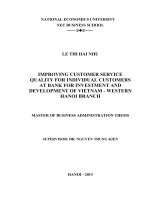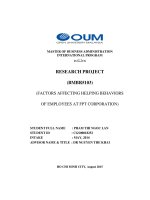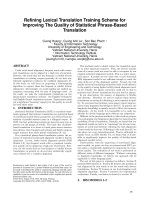improving training quality for new employees at fpt corporation
Bạn đang xem bản rút gọn của tài liệu. Xem và tải ngay bản đầy đủ của tài liệu tại đây (300.48 KB, 17 trang )
National economics university
Neu busi ness sch ool
Khong thi thuy linh
IMPROVING TRAINING QUALITY FOR NEW EMPLOYEES
AT FPT CORPORATION
IN T ROD UC T ION AN D T H EO R ET ICA L F R A M EWO R K
SUPERVISOR: Ms. LE THI BICH NGOC
Hanoi – 2013
2
FPT CORPORATION
FPTCorporation(FPT) is one of the most successful multinational
information technology companies of Vietnam and is considered as leading
conglomerate in. It has branches in 14 countries and this number is increasing fast.
FPT has 8 subsidiary companies which operates in software outsourcing,
telecommunications, property, education and financial services
FPT HISTORY AND MILESTONES
FPT was founded on September 13, 1988, initially named the Food
Processing Technology Company. FPT firstly started up as a state-owned enterprise
engaging in import and export business of food and processed food. The company
had import and export relations with Eastern Europe and the Soviet Unionwith the
products including dried bananas, potatoes, cassava, etc.
On October 27, 1990, the company was renamed to The Corporation for
Financing and Promoting Technology to focus on IT businesses. The contract to
provide computers for the Russian Academy of Sciences and partnership with
Olivetti in 1989 was the foundation of the later IT department. Only after 8 years of
development, FPT confirmed its No. 1 position in IT industry of Vietnam
In 1999, FPT started up Software Outsourcing Center (currently known as
FPT Software - FSOFT) to export software to Europe, North America and Japan.
December 13, 2006 saw the IPO (Initial public offering) of FPT Corporation.
FPT stock was officially listed on the Ho Chi Minh City Stock Trading Center
(currently known as Ho Chi Minh City Stock Exchange – HOSE).
In 2008, the company was renamed to FPT Corporation, reconfirming its core
businesses in telecommunications, content industry and IT services.
In 2012, FPT Corporation started investing in researches on new technology
trends including Mobility, Cloud, Big Data and IT solutions as infrastructure of
infrastructure including E-government, Smart transportation and Smart Health.
2
3
FPT VISION
FPT strives to be a company guided by technological innovations,
committed to the highest level of customer satisfaction, contributing to
national prosperity and providing its employees with the most favorable
work environment possible, enabling them to reach their full potential in
their professional careers as well as their spiritual lives.
I. FPT CORPORATIONSTRATEGY AND MANAGEMENT SYSTEM
1. STRATEGY: FPT aims at being top enterprise in IT infrastructure and services.
Information technology and telecommunications will continue to be the foundation
technology in the digital convergence trend to meet and deliver the products and
services most convenient for e-citizens. This is the most important directions the
development strategy of FPT Corporation.
With the direction of “Be Smarter” noted in OneFPT strategy and initial
achievements, the target of OneFPT strategy until 2024 is explicated as “To become
a Global Leader in Smart Services”. The Board of Directors has agreed that in 2013,
FPT will continue with strong investments in services segments, in technology
development to set a foundation for the years to come. In the long term, FPT will
achieve the strategic target by the following three main ways:
- Generating new revenue by new services, products and markets which are
characterized and differentiated by ‘SMART’ feature, and realized
through Instrumentation, Interconnection, and Intelligence steps.
- Continuously innovating in traditional core businesses in order to
maintain stable growth, leading and outstanding positions in the industry.
- Prioritizing in modernizing the administration system and upgrading maturity
level of all procedures to improve company’s product & service quality.
2. FPT Management Systemrepresents FPT’s culture, built on the explicitness to
guide FPT’s employees on the way to think, work, act and interact.
II. ORGANIZATIONAL STRUCTURE AND CULTURE
1. FPT ORGANIZATIONAL STRUCTURE
3
4
Board of Directors
Mr. Truong Gia Binh – Chairman
Mr. Bui Quang Ngoc – Vice Chairman
Mr. Do Cao Bao – Member of Directors Board
Mr. Truong Dinh Anh – Member of Directors Board
Ms. Le Nu Thuy Duong - Member of Directors Board
Mr. Le Song Lai - Member of Directors Board
Mr. Jean CherlesBelliol - Member of Directors Board
Board of
Management
Mr. Bui Quang Ngoc - Chief Executive Officer (CEO)
Mr. Nguyen The Phuong - Vice General Director
Ms. Chu Thị Thanh Ha - Vice General Director
Supervisory Board
Mr. Nguyen Viet Thang – Head of Supervisory Board
Mr. Nguyen KhaiHoan – Member of Supervisory Board
Mr. Cao Duy Ha – Member of Supervisory Board
4
5
2. FPT CULTURE
FPT has paid special attention to identifying a unique business culture. For the
past twenty-three years, valuable characteristics have been formed, making FPT’s
culture distinctive and become the pride of each employee, contributing remarkable
part to today success of the company. FPT’s culture is the connecting glue to bind
each FPT people, encouraging them to work passionately and devote more to the
company’s development. FPT’s culture is reflected first and foremost in the
treatment among its employees and leaders. FPT people respect individuality,
innovation and teamwork while leaders of different levels should be dedicative,
exemplary and perspicacious
FPT system of core spiritual values includes:
• Respect individuals
- Be frank
- Be honest
- Be tolerant
• Innovation
- Constantly learn
- Constantly be creative
• Teamwork
- Be unanimous
- Be sincere
• Management
- Be exemplary
- Be judicious
5
6
CHAPTER 1: INTRODUCTION
1.1. RATIONALE
In the historical development of the social and economic patterns, people are
always regarded as the most important factor, determining the existence of social
development. People always actively create all material, wealth, culture and society.
In our history of national construction and defense, the role of human factor is also
demonstrated.
To promote the industrialization and modernization of the country, starting
from the National Congress VI (1986), Government has proposed the renewal of the
country. From this event, after 15 years of innovation, many businesses have rightly
recognized the importance of the human factor, has proposed a number of effective
measurements to address the relationship between personal interests - collective
interests - social and obtained encouraging success.
FPT Corporation is one of the leading companies in ICT (Information and
Communications Technology) field. In competitive market, organizations pay much
attention on maintenance and development of workforce quality, quantity in
consistent with the requirements of transport, cargo transport, production business,
ensuring organization’s development and integration, competition and success in
the future. FPT is proud to be home to the largest number of IT engineers in
Vietnam. They are the most precious property to whom FPT attributes its every
success. It is the reason why I choose the topic “Improving training activities for
new employees at FPT Corporation” to be my graduation thesis.
1.2. RESEARCH OBJECTIVES
Objectives of research study are formulated as following:
• Research some basic theories required for training activities of FPT
Corporation’s new employees
• Review and analyze current training activities for FPT Corporation’s new
employees
• Propose some recommendations to improve FPT Corporation training
activities for new employees
1.3. RESEARCH QUESTIONS
• What are the training activities that FPT Corporation has employed for new
employees?
6
7
• What are the effects of new-employee-training activities that FPT
Corporation has employed?
• What are the elements affecting new-employee-training activities in FPT
Corporation.
• What does FPT Corporation need to improve new-employee-training
activities?
• How does FPT Corporation improve new-employee-training activities?
1.4. RESEARCH METHODOLOGY
1.4.1. Research process
Source: Author’s design
1.4.2. Data collection
1.4.2.1. Secondary data collection
Secondary data were collected under desk study form from newspapers,
journals, websites, annual reports, reviews and former research studies related to
training activities within three years (2011, 2012, 2013); and from FPT Corporation
in 2012 and 2013.
1.4.2.2. Primary data collection
Approach Instrument Respondent Information
In-depth
interview
Questionnaire Ms. Ngo Thi Duy Phuong
– Training manager of FPT
FPT’s current
training situation
7
8
Corporation
Ms. Nguyen Thi Bich
Ngoc – Training staff of
FPT Corporation
Mr. Bui Minh Tuan –
Training staff of FPT
Corporation
The difficulties
and advantages
when
implementing FPT
training activities
Training plan of
FPT
Awareness about
FPT training
activities
Survey
Questions
and answers
guidelines
50 target new employees
Evaluate the
effects of FPT
training activities
Which training
activity is effective
for FPT new
employees?
Primary data were collected by in-depth interviewing with FPT Corporation’s
training manager and staff and by surveying target new employees of FPT’s
Corporation. Therefore, there are two instruments for analysis method:
In-depth interview was carried out with 1 manager: Ms. Ngo Thi Duy Phuong
– FPT Corporation training manager; and 2 training staff: Ms. Nguyen Thi
Bich Ngoc and Mr. Bui Minh Tuan. This in-depth interview was conducted
directly by the author. For FPT Corporation manager, questions are set out in
order to evaluate FPT current training activities. The questions also aimed at
the advantage and disadvantage when implementing training activities for new
employees at managers’ view points and the plan for FPT new-employee-
training in the future. For FPT training staff, the questions focused on the
advantage and disadvantage when implementing training activities for new
employees at staff’s view points and the awareness of them on training.
New employee surveys:
• Sample size
As the purpose of this study, I collected data from new employees which are chosen
randomly based on FPT employee database. The total number is 50. I sent survey to
employees by email and face-to-face.
• Instrument: Survey
8
9
• Information: The survey was design to know how new employees evaluate
FPT training program, which kind of training program in FPT is the most
effective and how FPT gains more attention to training program.
1.4.2.3. Analyzing data method
The author uses Excel software to synthesize the result of the questionnaire.
1.5. SCOPE OF THE RESEARCH
The research was conducted in Hanoi only. In which, the target employees were
selected randomly from FPT head office and subsidiaries in Hanoi.
The secondary data was collected from 2011 to 2013 and the primary data was
conducted in December 2013.
1.6. STRUCTURE OF THE THESIS
Apart from acknowledgement, abbreviation, executive summary, appendixes and
conclusion, the thesis consists of four chapters:
Chapter 1: INTRODUCTION
Chapter 2: THEORETICAL BACKGROUND ON TRAINING
Chapter 3: CURRENT SITUATION ON NEW-EMPLOYEE-TRAINING
ACTIVITIES AT FPT CORPORATION
Chapter 4: RECOMMENDATIONS ON NEW-EMPLOYEE-TRAINING
ACTIVITIES AT FPT CORPORATION
CHAPTER 2: THEORETICAL BACKGROUND ON TRAINING
2.1. DEFINITION OF TRAINING
Training is a part of Training and development - the field which is
concerned with organizational activity aimed at bettering the performance of
individuals and groups in organizational settings. It has been known by several
names, including human resource development, and learning and development.
Training is the acquisition of knowledge, skills, and competencies as a result
of the teaching of vocational or practical skills and knowledge that relate to specific
useful competencies. The goal of training is to improve people’s capability,
capacity, productivity and performance. Different professions and occupations have
different sort of training.
9
10
According to author Nguyen Huu Than: "Training includes activities aiming
at improving professional skills or personal skills for current job.” Another
definition is: "Training and development is a process that allows people to
acquire the knowledge, learn new skills and change perspective, improve
behavior and ability to the work of individuals.” Training focuses on the present,
on the actual work of the individual, on the shortage skills of workers, helping them
with the right skills which are necessary to perform the job.
Training and human resource development is an activity organized and controlled
by the enterprise. It determines to bring a change of perception, qualifications, skills,
and awareness of employees for their work. Training and development relate
organizations and individuals. The content of the training may include:
Training professional expertise: In this workers are equipped with theoretical
knowledge and professional skills.
Advanced Training: The process of training, improving theoretical knowledge
and practical skills so that employees can continue to fulfill their job better and
complete assigned tasks more precisely.
New training: training people who have not participated or who have participated in
the production process but have not had specific job.
2.2. THE IMPORTANCE OF TRAINING
Even though training process takes up cost and time, its advantages make the
process worthwhile. Firstly, training addresses employees’ weakness. As all
employees have some imperfections, training help strengthen the skills that each
employee needs to improve their performance. Providing the necessary training
creates an overall knowledgeable staff with employees who can take over for one
another as needed, work on teams or work independently without constant help and
supervision from others. Training also increase employees’ performance as it
provides employees necessary skills and knowledge for specific jobs. The training
may also build the employee's confidence because she has a stronger understanding
of the industry and the responsibilities of her job. This confidence may push her to
10
11
perform even better and think of new ideas that help her excel. Continuous training
also keeps your employees on the cutting edge of industry developments. Besides,
continuously training creates consistent experience and background knowledge,
which may increase the loyalty of employees towards organization. Finally, all
leads to the satisfaction of employees, as they have acquired the skills they need to
be excel at job.
2.3. THE RELATIONSHIP BETWEEN TRAINING AND OTHER
HUMAN RESOURCE MANAGEMENT PERSPECTIVES
Human resource management is an important component of executive function, it
has roots and branches spread across all organizations. Human resource does not
only create goods and service, they also create corporate culture. This is one of the
factors determining the success or failure of a business. Training, as a part of HR
management, defines the workforce based on the need and strategy of corporation.
It is like a house light to guide employees towards the corporation’s final goals.
Good training is the foundation for other steps in HR management, including
evaluating and retraining.
We live in an era where the rhythm changes occur with dizzying speed with the
explosion of information technology. It affects the production process, supply
chain, management process, etc. Therefore, the leaders felt the need to equip all the
new knowledge and skills to keep up with any changes. The demand for education,
training and human resource development as it becomes ever more urgent.
Training and human resource development not only has a great impact on the socio-
economic development of the country but also affect the international
competitiveness of enterprises. Training and human resource development has great
significance to offset the shortage of each employee, helping employees improve
themselves and work hard, develop their abilities; improved self-control, self-
management, self- monitoring, self-responsibility before they are assigned tasks in
order to limit the risk of accidents due to unnecessary shortages . It also help
increase loyalty among employees towards company.
11
12
2.4. TRAINING TYPES
There are many ways to classify training types. This thesis supports the following
way of breaking down training into 3 basic types:
2.4.1. Induction training
Induction training is also known as “Orientation training”. Its purpose is to
introduce new employees to new working environment. Normally, induction
training focuses on introducing to colleagues; explaining the organization’s
activities, procedures, structure and culture; working place tour; etc.
2.4.2. On-the-job training
This is one of the most common training types at work, where employee gets
training by watching a more experienced worker doing the job. The worker gets
trained while he is performing his regular duties. The employee is able to try out
new skills in real situations. Therefore, on-the-job training is suitable for unskilled
or semi-skilled jobs.
We can breakdown on-the-job training into subcategories, including:
- Coaching: Coaching is one-to-one interaction. It is considered as corrective
measure for inadequate performance. It helps identify weaknesses and
focuses on areas which need improvement.
- Mentoring: Mentoring is also one-to-one interaction, focusing on attitude
development. It is normally conducted for management-level employees and
done by someone inside the company.
- Job rotation: This method allows employees to switch from job to job.
Therefore, employees will have knowledge and skills in more than one job,
helping them have a general view about the whole process.
- Job instruction technique
2.4.3. Off-the-job training
This is the training type which employees go away from the place of work to
attend a special course. The training can be in the form of a seminar, workshop or a
college course. Off-the-job training is suitable for managerial level employees, or
for training soft skills. Off-the-job training tends to be more expensive due to
12
13
trainers’ fees and because the employees are unable to produce any work while they
are away. However, off-the-job training enables employees to look at a wider
variety of approaches and can provide a refreshing change of scene.
13
14
TRAINING
TYPES
ADVANTAGES DISADVANTAGES
Induction
training
• Higher retention rate
• Accurate information
• New employees feel welcomed
• Clear expectations are
established
• Costly
• Time-consuming
On-the-job
training
• Generally more cost effective
• Less disruptive to the business
• Familiar equipment and people
• Gain direct experience
• Productive (employees will
work as they are learning)
• Possibility Of
Accidents
• Low Productivity
• No Goals or
Evaluation
Off-the-job
training
• Learn from specialist
• More reality-based
• Response better
• Directly applies to jobs
• Higher chance of retention
• Time consuming
• Expensive
• Require skilled
trainers
2.5. TRAINING PROCESS
Training requires a chain of complicating activities. The training process
basically has five steps: Identify training needs, select appropriate training methods,
implement programs, and evaluate program and feedback.
2.5.1. Identify training needs
This step is crucial to figure out what needs to be trained, or whether it is
necessary to have a training course. To analyze training needs, organization can use
surveys, observations, interviews, and customer comment cards. The objective in
establishing a needs analysis is to find out the answers to the following questions:
− “Why” is training needed?
− “What” type of training is needed?
− “When” is the training needed?
− “Where” is the training needed?
− “Who” needs the training? and "Who" will conduct the training?
− “How” will the training be performed?
The needs analysis is the starting point for all training. The primary objective
of all training is to improve individual and organizational performance. Establishing
a needs analysis is, and should always be the first step of the training process.
14
15
2.5.2. Select Appropriate Methods
Training methods are desired means of attaining training objectives. Once
organization has figured out the need for training, it must choose a method that is
best suitable. It can either be induction training, on-the-job training or off-the-job
training. Training method needs to fit organization goals, culture as well as budget.
2.5.3. Implement Programs
After the selection of an appropriate method, the actual functioning takes
place. This step is responsible for the instruction and delivery of the training
program. Under this step, the prepared plans and programs are implemented to get
the desired output. Under it, employees are trained to develop for better
performance of organizational activities. For a training program to be successful, it
is essential that the trainer is conscious of several essential elements, including a
controlled environment, good planning, and the use of various training methods,
good communication skills, and trainee participation.
2.5.4. Evaluate Program
This step will determine how effective and profitable your training program
has been. It consists of an evaluation of various aspects of training in order to know
whether the training program was effective. In other words, it refers to the training
utility in terms of effect of training on employees' performance. The evaluation of
training programs is without a doubt the most important step in the training process.
It is this step that will indicate the effectiveness of both the training as well as the
trainer. Finally, a feedback mechanism is created in order to identify the weak areas
in the training program and improve the same in future. For this purpose,
information relating to class room, food, lodging etc. is obtained from participants.
The obtained information, then, tabulated, evaluated, and analyzed in order to mark
weak areas of training programs and for future improvements.
15
16
2.6. TRAINING’S DETERMINANTS
There are plenty of factors which affect training in organization. This thesis
prefers to classify those determinants into two categories: external and internal factors.
2.6.1. External determinants
- Economic development trend within the country: The trend of economic
development and the economic cycle of the industries have a great influence to
human development in particular and human resource management in general.
During the period of economic downturn or economic uncertainty, businesses
face the need to maintain skilled force and reduce labor costs. Therefore,
enterprises need to make the decision to change human resource development
program. In contrast, when the economy develops and be stable, businesses need
to develop human resources in both quantity and quality, enhance training,
coaching, and develop workers, who are the main asset of any organization.
- The scale and speed of population growth - residential structure: In general,
the growth rate of the population of a nation has great impact on the demand for
human resources development of the business. The larger the population, the
higher the demand for job. Businesses have to adjust the plans to develop its
human resources to suit both population growth rate as well as demand for job.
- Management mechanism – legal system: The law of the state have a strong
influence on the development of corporation’s human resources. The law
requires businesses to pay attention to the legitimate interests of the employees,
including the need for career development and the need for promotion. The laws
also bind the employer provisions of the company, requiring companies to have
staff development programs as appropriate time work, working conditions,
proper rest mode.
- The intensity of competition: In market, enterprises not only compete in market,
products, but also compete in human resources, as human is the decisive factor
16
17
in business success. To survive and grow, businesses need to develop human
resources. People leave the company not simple because of wages and benefits
but also from many factors, of which the most important factor is the chance to
develop. So, the competition is a huge factor to influence the development of
human resources of the company.
2.6.2. Internal determinants
- Business’s orientation and development objectives: Every organization has
its own development goals, expressed through the functions and tasks of
business development in each period. The goal of business development will
pose specific requirements for manpower to suit the requirements and
expertise to each department based on business goals to set goals for their
department.
- Business’s policy and strategies: The business policies generally belong to
the field of human resources and depending on the strategy used by
businesses. Some policies have a huge impact in the training and
development of human resources such as wage policies, incentives,
encouraging employees to work out of his ability, with high productivity.
- Business culture: Organizations have their own culture. This culture is
defined as a system of values, beliefs and practices shared within an
organization, the impact on the formal structure created behavioral norms.
The culture evolution and enterprise are affected by the senior executives,
mostly from what they did rather than what they say.
17









